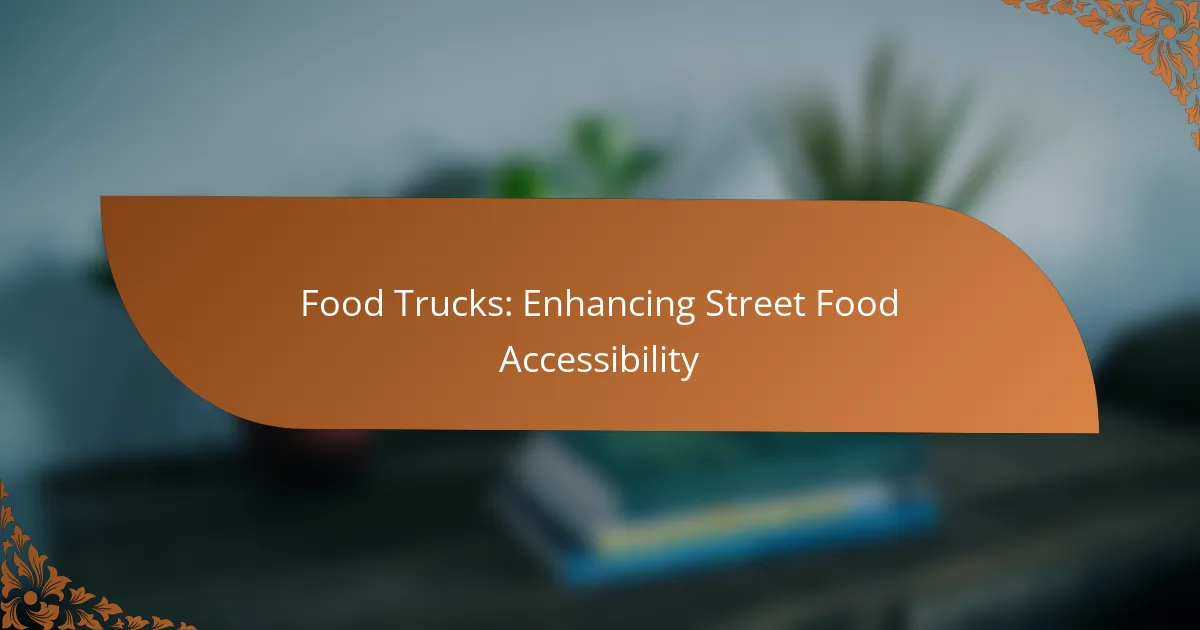Food trucks play a crucial role in enhancing street food accessibility by providing a wide range of culinary options that cater to diverse tastes and budgets. By offering affordable and convenient meals in various locations, they not only stimulate local economies but also foster community engagement and satisfaction among consumers.

How Do Food Trucks Enhance Street Food Accessibility?
Food trucks significantly enhance street food accessibility by offering diverse culinary options at various price points and locations. They create opportunities for consumers to enjoy meals that are often more affordable and convenient than traditional restaurants.
Increased variety of food options
Food trucks provide a wide range of culinary choices, from gourmet burgers to ethnic cuisines, catering to diverse tastes and dietary preferences. This variety allows consumers to explore different flavors without the commitment of a sit-down restaurant.
Many food trucks rotate their menus frequently, introducing seasonal ingredients and unique dishes that keep the offerings fresh and exciting. This adaptability helps them respond to local trends and customer feedback quickly.
Lower barriers to entry for vendors
Starting a food truck business typically requires less capital than opening a full-scale restaurant, making it an attractive option for aspiring chefs and entrepreneurs. Costs associated with permits, equipment, and initial inventory are generally lower, allowing more individuals to enter the food industry.
Additionally, food trucks often face fewer regulatory hurdles compared to brick-and-mortar establishments, enabling quicker setup and operation. This accessibility encourages innovation and creativity among vendors, leading to a vibrant food scene.
Convenient locations for consumers
Food trucks can be strategically placed in high-traffic areas, such as parks, office districts, and event venues, making it easy for consumers to access meals on the go. Their mobility allows them to serve different neighborhoods and adapt to local demand.
Many food trucks utilize social media to announce their locations and hours, helping consumers find them easily. This direct communication fosters a loyal customer base and enhances the overall street food experience.

What Are the Key Benefits of Food Trucks?
Food trucks offer numerous advantages, making street food more accessible and appealing to a wider audience. They provide affordable dining options, stimulate local economies, and allow for flexible business operations, which can lead to increased customer satisfaction and community engagement.
Affordability for consumers
Food trucks typically have lower overhead costs compared to traditional restaurants, allowing them to offer meals at competitive prices. Consumers can often find meals ranging from $5 to $15, making them an attractive option for budget-conscious diners.
This affordability encourages more frequent purchases, as people are more likely to try new cuisines without a significant financial commitment. Additionally, many food trucks offer daily specials or discounts, further enhancing their value proposition.
Support for local economies
Food trucks play a vital role in boosting local economies by creating jobs and supporting local suppliers. They often source ingredients from nearby farms and markets, which helps keep money within the community.
Moreover, food trucks can attract foot traffic to specific areas, benefiting other local businesses. This synergy fosters a vibrant street food culture that enhances community identity and encourages entrepreneurship.
Flexibility in operations
The mobility of food trucks allows operators to adapt quickly to changing market conditions and consumer preferences. They can easily relocate to different neighborhoods or events, maximizing their exposure and customer base.
This flexibility also enables food truck owners to experiment with menus and concepts without the long-term commitment associated with brick-and-mortar establishments. Seasonal offerings or themed events can be introduced, keeping the dining experience fresh and engaging for customers.

What Are the Challenges Faced by Food Truck Owners?
Food truck owners encounter various challenges that can impact their operations and profitability. Key issues include navigating regulatory compliance, competing with traditional restaurants, and managing seasonal fluctuations in customer demand.
Regulatory compliance issues
Food truck owners must adhere to numerous regulations that can vary significantly by location. These regulations often include health codes, licensing requirements, and zoning laws, which can complicate operations and increase costs.
For example, obtaining the necessary permits may require inspections and fees, which can range from a few hundred to several thousand dollars depending on the city. Staying informed about local laws is crucial to avoid fines or shutdowns.
Competition with brick-and-mortar restaurants
Food trucks face stiff competition from established brick-and-mortar restaurants that often have loyal customer bases and more extensive resources. This competition can make it challenging for food trucks to attract customers, especially in busy urban areas.
To stand out, food truck owners should focus on unique menu offerings, exceptional customer service, and effective marketing strategies, such as social media engagement and location tracking through apps.
Seasonal fluctuations in business
Seasonal changes can significantly affect food truck sales, with warmer months typically seeing higher customer traffic. In colder climates, food trucks may experience a drop in business during winter months, leading to inconsistent revenue streams.
To mitigate this, food truck owners can consider diversifying their offerings, such as providing catering services or participating in winter markets, to maintain income during off-peak seasons. Planning for these fluctuations is essential for long-term sustainability.

How to Choose the Right Food Truck for Your Business?
Choosing the right food truck for your business involves understanding your target market, selecting the appropriate truck model, and complying with local regulations. Each of these factors plays a crucial role in ensuring your food truck venture is successful and sustainable.
Assessing target market needs
To effectively assess your target market’s needs, start by identifying the demographics of your potential customers. Consider factors such as age, income level, and dietary preferences, as these will influence your menu offerings.
Conduct surveys or engage with local communities to gather insights about their food preferences. For example, if you’re in a college town, offering affordable, quick meals may attract students, while a business district might favor gourmet options.
Evaluating food truck models
When evaluating food truck models, consider the size, layout, and equipment of the truck. A smaller truck may be more maneuverable and cost-effective, but it could limit your menu options and storage capacity.
Research different models available in your area, focusing on their features and price ranges. For instance, a fully equipped truck might cost between $50,000 and $100,000, while a basic model could be significantly less. Assess your budget and operational needs to find the best fit.
Understanding local regulations
Understanding local regulations is essential for operating a food truck. Each city or region has specific licensing, health codes, and zoning laws that you must comply with to avoid fines or shutdowns.
Start by checking with your local health department and city council for the necessary permits and regulations. For example, some areas may require a food handler’s permit, while others might have restrictions on where you can park and sell food. Familiarize yourself with these requirements early to streamline your launch process.

What Are the Best Locations for Food Trucks?
The best locations for food trucks are those that maximize visibility and accessibility to potential customers. Key factors include foot traffic, local events, and strategic partnerships with nearby businesses.
High foot traffic areas
High foot traffic areas are prime spots for food trucks, as they attract a larger number of potential customers. Locations such as busy intersections, shopping districts, and parks are ideal since they see consistent pedestrian movement throughout the day.
When selecting a site, consider the time of day and peak hours. For example, lunch hours around office buildings or evening crowds near entertainment venues can significantly boost sales. Always check local regulations regarding permits and designated food truck zones.
Events and festivals
Events and festivals provide excellent opportunities for food trucks to reach a concentrated audience. These gatherings often draw large crowds who are eager to try diverse food options, making them ideal for maximizing sales.
To participate, research local event calendars and apply for vendor spots well in advance. Be prepared to offer unique menu items that cater to the event’s theme or audience preferences, which can enhance your visibility and attract more customers.
Partnerships with local businesses
Forming partnerships with local businesses can significantly enhance a food truck’s reach. Collaborating with nearby offices, breweries, or retail stores can create a mutually beneficial relationship, where the food truck provides convenient meal options for employees or customers.
Consider offering special promotions or catering services for business events to strengthen these partnerships. This not only increases foot traffic but also builds a loyal customer base that appreciates the convenience of having quality food nearby.

How Do Food Trucks Compare to Traditional Restaurants?
Food trucks offer a unique dining experience that contrasts with traditional restaurants in several ways, including flexibility, cost, and menu variety. They typically have lower overhead costs and can quickly adapt to changing consumer preferences, making them an appealing option for many food lovers.
Cost structure differences
The cost structure of food trucks differs significantly from that of traditional restaurants. Food trucks generally have lower startup and operational costs, as they do not require expensive real estate or extensive staff. This allows them to offer competitive pricing, often resulting in meals that are more affordable than those found in brick-and-mortar establishments.
For example, while a traditional restaurant may have fixed costs like rent and utilities that can run into thousands of dollars monthly, a food truck’s expenses might include fuel, maintenance, and permits, which can total a few hundred to a couple of thousand dollars. This difference in costs can lead to lower menu prices, often making food trucks an attractive option for budget-conscious consumers.
However, food trucks face their own challenges, such as limited space for equipment and inventory, which can affect menu variety and pricing strategies. It’s essential for food truck operators to carefully manage their resources to maintain profitability while still offering appealing options to customers.
